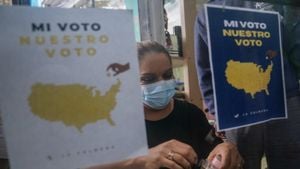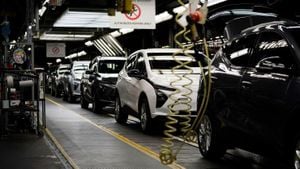Air pollution crises have become increasingly common across major cities worldwide, but few have faced the dual challenges present in Delhi and Lahore. Both cities, which lie within proximity of one another, are experiencing severe deterioration of air quality, leading to significant public health concerns and governmental interventions. The air quality levels have seen alarming spikes recently, causing citizens to steer clear of outdoor activities and prompting officials to take drastic measures to combat the pollution.
Urban centers like Delhi, which has long been known for its pollution challenges, are now reporting worsening air quality readings. On November 4, Delhi's Air Quality Index (AQI) soared to 433, classifying it as 'severe.' This marked the highest levels recorded for the season, and conditions were exacerbated by stagnant weather patterns, which allowed pollutants to linger and accumulate. Residents have noted the visibility-challenging smog and the overwhelming smell of burning industrial waste permeated their daily commutes.
Delhi’s air quality dipped significantly during this period, continuing to fall under the 'very poor' category, defined by AQI readings between 301 and 400. Areas like Anand Vihar and Ashok Vihar logged some of the worst readings, hitting peaks of 421 and 409 respectively. The primary contributor to this toxicity is particulate matter, which consistently exceeded multiple health standards throughout this period.
Efforts from local governmental bodies have included the deployment of mobile anti-smog guns to mitigate dust pollution and control urban emissions. Delhi Environment Minister Gopal Rai announced plans to utilize these advanced spray systems throughout all assembly constituencies. This initiative, combined with the crackdown on vehicles without valid pollution control certificates, is part of the city’s broader strategy to combat its chronic air issues.
Meanwhile, the other side of the border, Lahore has found itself at the helm of the world’s polluted cities list. On the same days as Delhi's alarming AQI spikes, Lahore registered mind-boggling levels of pollution reaching as high as 1900, primarily due to PM2.5 particulate matter readings. Authorities responded by closing all primary schools for at least one week as the thick smog shrouded the city, prompting health warnings from officials who advised the public to remain indoors.
Local authorities, pickled with complicated air quality concerns, attributed the unbearable smog to various sources, including agricultural waste burning from nearby Indian states. The Punjab provincial government declared the poor air quality as partially stemming from winds carrying pollutants from India. Senior Minister Marriyum Aurangzeb emphasized the need for dialogue before effective solutions can be realized, claiming, “This cannot be solved without talks with India.” This highlights the intensifying geopolitical tensions surrounding environmental issues but also reflects the interdependent nature of air pollution as a shared dilemma.
Despite the emphasis on external factors, growing evidence suggests Lahore’s pollution problem is compounded by internal challenges, including vehicle emissions and industrial operations. With many areas being classified as hazardous, authorities rolled back live monitoring strategies to gauge pollution levels to implement more effective regulations against local emissions. Residents are urged to stay indoors, and steps have been taken to limit automobile use and close down construction works as part of immediate strategies to alleviate pollution impacts.
Both Delhi and Lahore continue to grapple with temperature inversions, especially during winter months when cool air traps smoggy clouds and inhibits the effective dispersion of pollutants. While both cities have made efforts to address the immediate air quality crises, the need for long-term planning and inter-regional collaboration has never been more urgent. Without these steps, the severe pollution plaguing both capitals may become the new normal, leading to long-term health ramifications for millions of residents.
Those living within these affected areas are particularly vulnerable. Health experts warn of the heightened risks associated with prolonged exposure to such toxic environments. Reports indicate elevated instances of respiratory and cardiovascular issues among already compromised demographics. Schools have been forced to adapt, implementing online learning methods to protect children from exposure, and workplaces are considering hybrid strategies to allow for remote working options.
Moving forward, residents of both cities continue to hope for real action and systemic changes from their governments. The acknowledgment of air pollution as not merely one city’s problem, but rather a shared regional issue could be the first step toward ensuring cleaner air for all. With both urban centers tightly interwoven by geography and economy, collaboration might be necessary not just for solving these issues, but even for the well-being of their respective populations.
Surrounding this regional air crisis are also the climate change discussions and policymaking efforts. Experts argue if these interconnected cities present unique instances of broader global environmental challenges, cooperation may provide necessary insights and solutions. Initiatives emphasizing clean energy, sustainable practices, and even air quality awareness could bring about healthier cities as long-forgotten air quality control methods are again brought to the forefront.
Though Delhi and Lahore have concrete initiatives laid out, the persistent nature of their air quality crises reflects broader systemic failures across both regions. While residents strive for immediate relief, the underlying assumption should ideally focus on reframing the air quality narrative from crisis management to proactive governance. It’s all about shifting the focus from reactionary measures to creating stable foundations for healthier urban environments and restoring public trust. The call for actionable change has become more amplified than ever—both cities now stand at the crossroads of action and judgment as the battle against pollution rages on.



